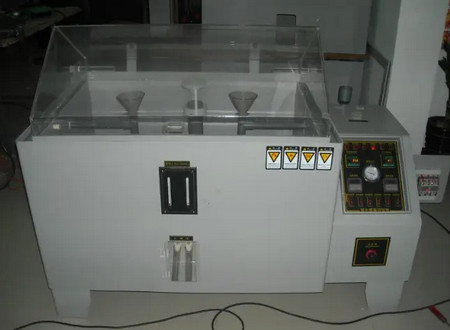
NewsInformation Center
What are NSS, AASS, and CASS in salt spray testing?
2023/06/27
Salt spray test is an environmental test that primarily uses artificial simulated salt spray environmental conditions created by salt spray testing equipment to assess the corrosion resistance of products or metal materials.

Salt spray corrosion is a common and most destructive atmospheric corrosion.
Salt spray test is an environmental test that primarily uses artificial simulated salt spray environmental conditions created by salt spray testing equipment to assess the corrosion resistance of products or metal materials.
The salt spray test is the salt spray test chamber. The quality of the salt spray corrosion resistance of the product is assessed in the salt spray environment created manually in its volume space. Compared with natural environments, the salt concentration of chloride in its salt spray environment can be several times or dozens of times that of general natural environments, greatly improving the corrosion rate. Conducting salt spray tests on products also greatly shortens the time for obtaining results.
If a product sample is tested in a natural exposure environment, it may take one year for corrosion to occur, while under artificially simulated salt spray environment conditions, similar results can be obtained within 24 hours. The artificial simulated salt spray test also includes neutral salt spray test (NSS), acetate spray test (AASS), and copper accelerated acetate spray test (CASS).
Definition of three types of experiments:
1. Neutral Salt Spray Test (NSS)
Neutral salt spray test (NSS) is the foundation of salt spray testing, which is a manually accelerated corrosion test.
Adjust the pH value of the salt solution prepared according to 1.1 to be between 6.5 and 7.2. The pH value can be measured using a pH meter or a precision pH test paper with a measurement accuracy of 0.3 for daily testing. The pH value of the solution can be adjusted with hydrochloric acid or sodium hydroxide. 24 hours is a cycle.
The loss of carbon dioxide in the solution during spray may cause pH changes. Corresponding measures should be taken, such as heating the solution to over 35 ℃ before sending it to the instrument or preparing the solution with new boiling water to reduce the carbon dioxide content in the solution and avoid changes in pH value.
2. Acetate Spray Test (AASS)
Acetate Spray Test (AASS) is a method of adding acid (acetic acid) to a salt solution to shorten the experimental time for plated parts such as cars driving in urban atmospheres.
Add an appropriate amount of glacial acetic acid to the salt solution prepared according to 1.1 to ensure that the pH value of the collected solution in the salt spray box is between 3.1 and 3.3. The pH value of the initially prepared solution ranges from 3.0 to 3.1. The pH value is measured using a pH meter, and as a daily test, a precision pH test paper with a measurement accuracy of 0.1 can also be used. The pH value of the solution can be adjusted with glacial acetic acid or sodium hydroxide.
Its corrosion rate is about three times faster than the neutral salt spray test.
3. Copper Accelerated Acetate Spray Test (CASS)
The Copper Accelerated Acetate Spray Test (CASS) was conducted by analyzing the composition of regional rainwater and conducting extensive research on accelerated additives. It was found that adding copper oxide to the acetate spray test can greatly increase the corrosiveness of the medium, and the corrosion characteristics are very similar to those of severe corrosion in actual situations. Therefore, an accelerated CASS test method was further developed.
In the salt solution prepared as above, add Copper(II) chloride (CuCl2.2H2O) with a concentration of 0.26g/L ± 0.02g/L (that is, 0.205g/L ± 0.015g/L anhydrous Copper(II) chloride). The method for adjusting the pH value of the solution is the same as AASS.
Its corrosion rate is approximately 8 times that of the neutral salt spray test.
How to choose a test?
It is mainly based on the material and coating of the sample.
1. Neutral Salt Spray Test (NSS)
Suitable for metals and their alloys, most metal coatings, metal coatings (anodic or cathodic), conversion coatings, anodic oxide coatings, organic coatings.
2. Acetate Spray Test (AASS)
Suitable for various inorganic and coated coatings, black and colored gold, such as copper nickel chromium coatings, nickel chromium coatings, aluminum salt spray test standard anodized films, etc.
3. Copper Accelerated Acetate Spray Test (CASS)
It can be used to test decorative coatings of copper/nickel/chromium or nickel/chromium, and to test anodic coatings on aluminum.
Salt spray testing is used in industries such as aerospace, aviation, shipbuilding, hardware and electronics, electrical appliances, chemical industry, postal and telecommunications, automobiles and motorcycles, industrial and mining enterprises, electroplating plants, quality inspection, and other departments. It can also be used in the heat treatment surface treatment industry, for example, the QPQ process plan requires smoke testing, so both heat treatment and surface treatment will be used.
The entire Jester salt spray box is made of imported gray white PVC board, and the interior adopts advanced ring belt production three-dimensional reinforcement technology. The structure is strong, never deformed, and resistant to acid and alkali, high temperature, and never aging. It is suitable for neutral salt spray test (NSS), acetate spray test (AASS), and copper accelerated acetate spray test (CASS).
Previous: Will the xenon lamp in the xenon lamp aging test chamber explode?
N e x t : The lamp tube of the xenon lamp aging box is broken, how to replace it?



